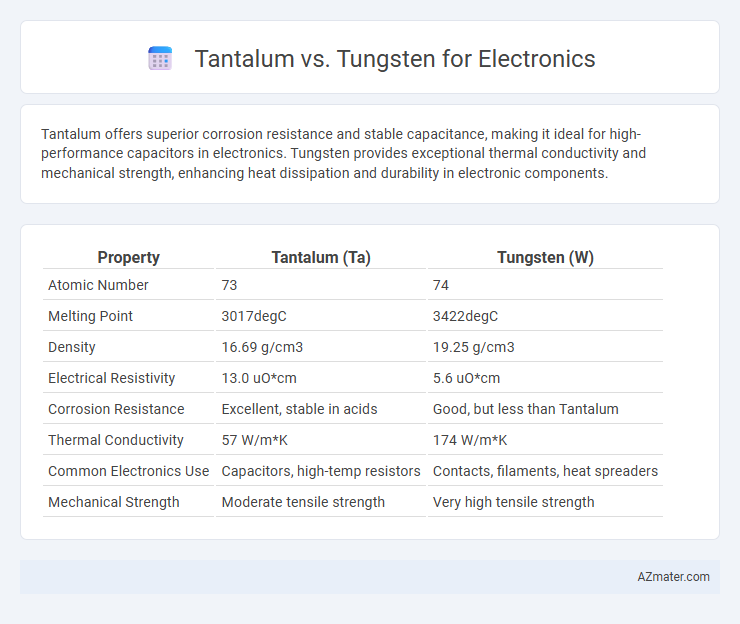Tantalum offers superior corrosion resistance and stable capacitance, making it ideal for high-performance capacitors in electronics. Tungsten provides exceptional thermal conductivity and mechanical strength, enhancing heat dissipation and durability in electronic components.
Table of Comparison
| Property | Tantalum (Ta) | Tungsten (W) |
|---|---|---|
| Atomic Number | 73 | 74 |
| Melting Point | 3017degC | 3422degC |
| Density | 16.69 g/cm3 | 19.25 g/cm3 |
| Electrical Resistivity | 13.0 uO*cm | 5.6 uO*cm |
| Corrosion Resistance | Excellent, stable in acids | Good, but less than Tantalum |
| Thermal Conductivity | 57 W/m*K | 174 W/m*K |
| Common Electronics Use | Capacitors, high-temp resistors | Contacts, filaments, heat spreaders |
| Mechanical Strength | Moderate tensile strength | Very high tensile strength |
Introduction to Tantalum and Tungsten in Electronics
Tantalum and tungsten are critical metals extensively used in the electronics industry due to their unique properties. Tantalum's high capacitance and corrosion resistance make it ideal for manufacturing capacitors in smartphones, laptops, and medical devices. Tungsten's exceptional thermal conductivity and high melting point enable its use in electronic contacts, filaments, and integrated circuit components where durability and heat resistance are paramount.
Material Properties Comparison
Tantalum offers excellent corrosion resistance and high capacitance per volume, making it ideal for reliable capacitors in miniaturized electronics, while tungsten is prized for its exceptional thermal conductivity and high melting point, suitable for high-temperature applications and electrode materials. Tantalum's lower electrical resistivity enhances its performance in electronic components requiring stable conductivity, whereas tungsten's mechanical strength and resistance to electromigration benefit contacts and interconnects in harsh environments. The distinct material properties of tantalum and tungsten drive their specialized roles in electronic devices, balancing factors like thermal management, electrical performance, and durability.
Electrical Conductivity Differences
Tantalum exhibits moderate electrical conductivity, making it ideal for capacitors and high-frequency electronic components due to its stable oxide layer that enhances dielectric properties. Tungsten, by contrast, has significantly higher electrical conductivity and exceptional thermal stability, which suits it for applications like filaments and contacts in high-temperature electronics. Understanding these conductivity differences helps engineers select the optimal metal based on performance needs in electronic circuit designs.
Thermal Stability and Performance
Tantalum exhibits superior thermal stability in electronics due to its high melting point of 3017degC and excellent corrosion resistance, ensuring consistent performance in high-temperature environments. Tungsten, with an even higher melting point of 3422degC, offers exceptional thermal conductivity and structural integrity, making it ideal for components subjected to extreme heat and mechanical stress. Both metals enhance electronic device reliability, but tungsten's thermal performance advantage suits applications requiring rapid heat dissipation and durability under severe operating conditions.
Corrosion Resistance in Electronic Applications
Tantalum demonstrates superior corrosion resistance compared to tungsten in electronic applications, making it ideal for components exposed to harsh environments and electrolytes. Its stable oxide layer protects circuits from oxidation and chemical degradation, ensuring long-term reliability in capacitors and high-frequency devices. Tungsten, while offering excellent mechanical strength, is more susceptible to oxidation and corrosion, limiting its use in moisture-prone electronic environments.
Miniaturization and Component Size
Tantalum capacitors offer superior volumetric efficiency and reliability, making them preferred for miniaturized electronic circuits requiring stable capacitance in limited spaces. Tungsten's high melting point and density contribute to its use in microelectromechanical systems (MEMS) and semiconductor contacts, where compactness and durability under thermal stress are critical. The choice between tantalum and tungsten influences component size reduction by balancing capacitance stability with mechanical robustness in advanced electronics.
Cost and Availability Factors
Tantalum offers superior capacitance and corrosion resistance, making it ideal for high-performance electronics, but its cost is significantly higher due to limited global supply and geopolitical mining constraints. Tungsten is more abundant and cost-effective, often used in applications requiring high thermal and electrical conductivity, though it lacks the specialized electrical properties of tantalum capacitors. The choice between tantalum and tungsten hinges on balancing budget constraints with performance requirements and component availability in the electronics market.
Environmental and Safety Considerations
Tantalum and tungsten are critical metals used in electronics, with tantalum favored for capacitor production and tungsten for electrical contacts and filaments. Environmental concerns regarding tantalum include the ethical sourcing challenges linked to conflict minerals in the Congo, whereas tungsten mining raises issues about energy-intensive processes and toxic waste. Safety considerations emphasize proper handling of tungsten dust to prevent respiratory issues, while tantalum production requires stringent controls to mitigate exposure to potentially harmful chemicals used in refining.
Common Uses in Electronic Devices
Tantalum capacitors are widely used in electronic devices for their high capacitance, stability, and reliability in miniaturized circuits such as smartphones, laptops, and hearing aids. Tungsten is primarily employed in electronic contacts, filaments, and semiconductor manufacturing due to its excellent conductivity, high melting point, and durability, particularly in aerospace and military electronics. Both metals are essential for advanced electronics, with tantalum favored for energy storage and tungsten for structural and conductive applications.
Choosing Between Tantalum and Tungsten for Electronics
Choosing between tantalum and tungsten for electronics requires evaluating their distinct electrical and physical properties. Tantalum excels in capacitors due to its excellent corrosion resistance, high capacitance per volume, and stability under varying temperatures. Tungsten, with its superior melting point and electrical conductivity, is preferred in applications demanding high thermal endurance and mechanical strength, such as in filaments and contacts.

Infographic: Tantalum vs Tungsten for Electronics
 azmater.com
azmater.com